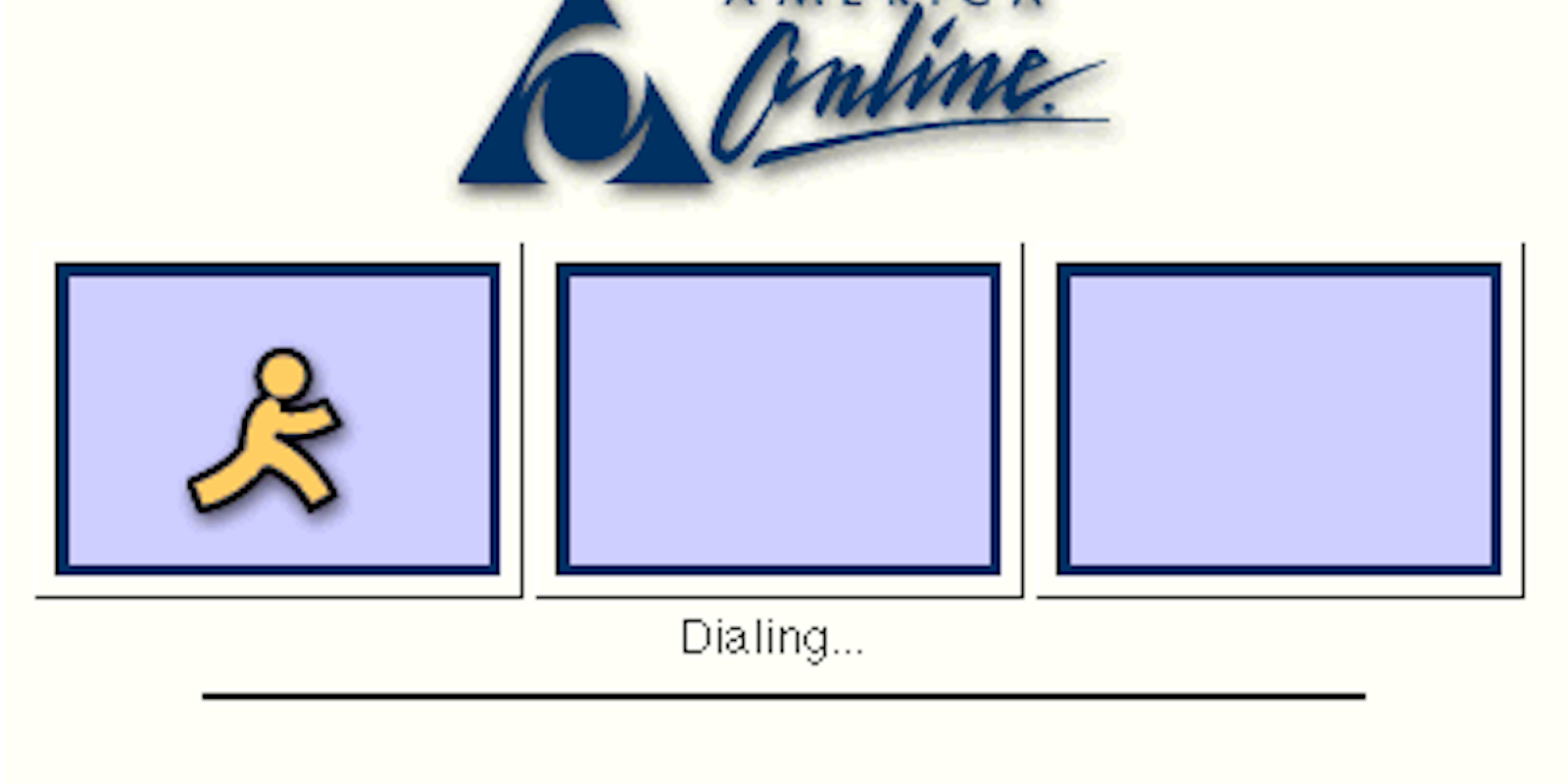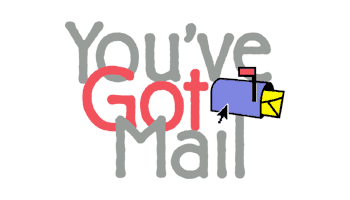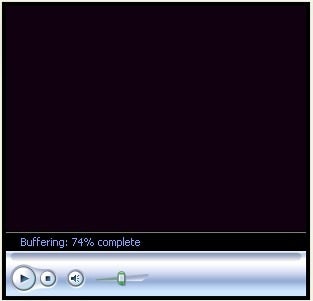Beeeeeep. Bong, bong. Beeeeeeeep. Hshhhhhhhht.
In the late 1990s and early 2000s, accessing the Internet was more than a pedestrian, everyday task. It was an accomplishment.
Photo via Hubspot
Believe it or not, there was a time when cable companies provided only television channels to households. “Cable modem” was a term that simply didn’t exist. Outside of high-powered networks that existed at work or school, our home Internet access largely came from something else: telephone lines.
In gym class, cable Internet was the star athlete with the near-flawless body who gave crippling wedgies. Telephone Internet service, meanwhile, was the out-of-shape kid clutching an inhaler, perpetually picked last.
Horrendously slow to begin with, telephone lines were also susceptible to all forms of interruption. Yet they were all we had.
America Online was the service provider of choice in those days. The program served as a gateway to the Internet as we know it, offering access to the Web as one of its many shiny features. AOL strived to be its own “Internet” of sorts, binding together users through a series of channels like entertainment, sports, etc. While navigating the program was easy, accessing it in the first place was an entirely different story.
Turning on
Today, getting online is as simple as double-clicking your Chrome, Mozilla, or Internet Explorer icon. In the late 1990s and early 2000s, however, there was a multi-step process involved:
1) Yell out to everyone in your household, “Is everyone off the phone? I want to get online!”
2) Repeat step 1 as necessary until the telephone line is, indeed, open for use.
3) Double-click the America Online button, enter your username and password, sign in.
4) A window will appear that reads “dialing.” Your computer modem will buzz to life and a series of sounds will spew from your speakers: a dial tone, a series of “bing”- and “bong”-like effects that sound like robots getting it on, and static.
5) Repeat step 4 as necessary. You rarely, if ever, connected on the first try.
Once the modem registered a successful connection, a few other icons would appear and we were met with this screen:
Photo via Hubspot
This was a more welcome sight than the face of whoever we were dating.
“Welcome,” the robotic male voice blurted out. The connection window vanished. In its place were the multicolored icons of the America Online home screen.
Photo via Coding Horror
If we were very lucky, we also heard the famous line:
Photo via Mind of the Geek
Of course, by the time we actually reached this point, we had forgotten why we had come online in the first place.
As we surfed (yes, people still referred to it as “surfing the World Wide Web” back then), we felt free, much more free than actual surfers riding the waves of an open ocean. Arching my spine ever closer to lifelong poor posture, my hands glided over the keys and mouse. I was communicating with my friends through instant message! I was reading what total strangers thought about last night’s Saturday Night Live episode! I was…
I was… wait…
I was kicked off.
My window to the world slammed shut. The dreaded “dialing” screen appeared again.
Of course, that meant someone in the house had picked up the phone and thus destroyed my connection. Doing this was on par with murder. After all, my friend Jon and I were right in the middle of a three-hour-long discussion over whether or not Fox should cancel The Simpsons now that Phil Hartman was dead, and I had basically vanished from the proceedings through no fault of my own.
“Get off the phone!” I yelled at whoever else was home.
“I didn’t know you were online!” yelled back my mother/father/sister. “I’ll be quick, I promise!”
I had no choice but to stop the connection (as it would never go through on a busy phone line) and stare glumly at the computer, which was now little more than a paperweight that played Solitaire. Even back then, I was a victim of “Internet time” (where a full minute seems like an entire day). Each second that the phone was tied up, I felt more disconnected from the world. I was a philistine. I was a mountain-dwelling hermit.
The agony over, I tried to reconnect. By this point, of course, AOL had gotten upset that I left it in such an abrupt manner and refused to grant access back online. It claimed a busy signal or some other random connection issue. That was the end.
A hint of salvation
With a lot more suddenly expected out of the household phone line, eager Internet pioneers yearned for something different. We envied those peers of ours who came from wealthier families and could afford the outright magic that was DSL.
Today, telling someone you use DSL to access the Internet is like saying that you use actual smoke signals to connect. When you and your friends had 56K modems beeping and flashing at you all hours of the day, however, such dedicated forms of connection were drooled upon.
After almost everyone in the house had yelled about phone calls interrupting service, my dad once spoke the greatest words anyone has ever said, edging out “we found a cure for polio” and “they’re renewing Seinfeld for a ninth season.” Those words?
“I got a separate phone line for the computer.”
We seriously thought we had left the shackles of the 20th century behind forever and entered the futuristic utopia promised by Star Trek for decades. Granted, warp speed, interaction with alien species, and Holodecks were not with us just yet. But we could now browse the Internet and talk on the phone at the same time.
While someone mindlessly picking up the phone would no longer affect our online experience, the occasional incoming call still could. The computer’s phone line was unlisted, but that wasn’t adequate protection from the many telemarketers out there. Every now and then, our service would inexplicably cut out, causing us to curse the entire telephone solicitation industry even more than we did during their dinner-interrupting rings in the days before caller ID.
Needless to say, like every other godsend out there, a dedicated phone line presented an entirely new problem.
Per-minute Internet
These days, you can be online for 24 straight hours and not see even the slightest shift in your monthly cable bill. When you connected with a phone line, however, it was different.
While we were fortunate enough to snag a service number in our area code, usage of a phone line still wasn’t free or even cheap. The massive loads of data sent back and forth through those wimpy little ethernet wires added up over time. On more than one occasion, my dad exploded at the arrival of high-three-digit phone bills.
Loading…
With a standard telephone line separating you from the rest of the Internet, the quick-loading websites and instant data downloads of today certainly weren’t the norm.
There was no such thing as streaming video, and there was definitely no such thing as live streaming video; the average household computer connection simply couldn’t handle that constant of a data transfer. Instead, there existed small snippets of video that could only be played through bastard programs like RealPlayer.
Photo via Michael’s Insight
Even pictures, which generally did not move, still took their sweet time loading onto the screen in the very beginning. If you’re over the age of, say, 25, this should look very familiar to you:
Photo via Kevin Ryder/Flickr
Needless to say, this was quite frustrating when there was highly desired porn underneath that eternal black box. Even more frustrating was the picture failing to load all the way, leaving you with just a ceiling or a head, which you of course could not pleasure yourself to (easily, anyway).
Downloading content was just as bad. Believe it or not, there was a time before the government and RIAA cracked down on programs like Kazaa, SoulSeek, and even Napster. People didn’t (yet) live in fear of organizations that sued middle-class teenagers $150 billion for ripping the latest Backstreet Boys track from a file-sharing program. That said, the sheer amount of time it took you to pirate something was enough to set you straight.
“I’m ready to go to Atlantic City for the day,” a good pirate friend of mine once said before one of our 10-hour outings to the New Jersey gambling community. “And when I get back home, I’ll have Star Trek: Insurrection almost fully downloaded!”
Things weren’t easy in those days (and having a slew of mediocre Star Trek movies didn’t help). But we pressed on with what we had. We lived with our limitations. There were rumors that some wizards in California were developing solutions to snail-pace download speeds, minute-by-minute charges, and interrupted service.
We dreamed of an Internet experience that, once we had a mere taste of it, would have us hooked. We grew faith in the tech industry. We knew we’d never want to return to our 56.6K modems or our finite selection of websites.
Folks, you definitely have it good these days. You have the ability to stay perpetually connected at the highest available speeds. A never-ending array of websites, images, and porn is never more than a few mouse clicks away.
You’ve earned it. You suffered through the crappiest of connections, developing a kind of Internet Stockholm Syndrome that made you the rip-smart editor, blogger, or Web designer you are today. The next time you’re drumming holes into your desk because it’s taking your laptop a little longer than usual to recognize the Wi-Fi network, try to remember that there was once a time when we…
Buffering…
Connection lost.








